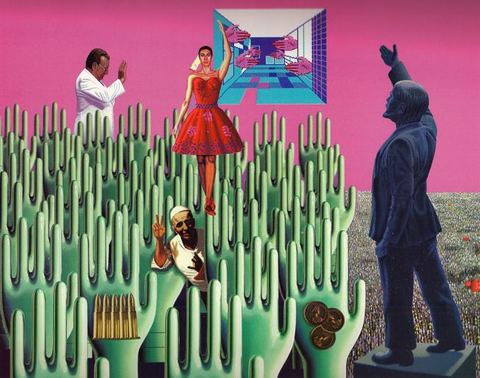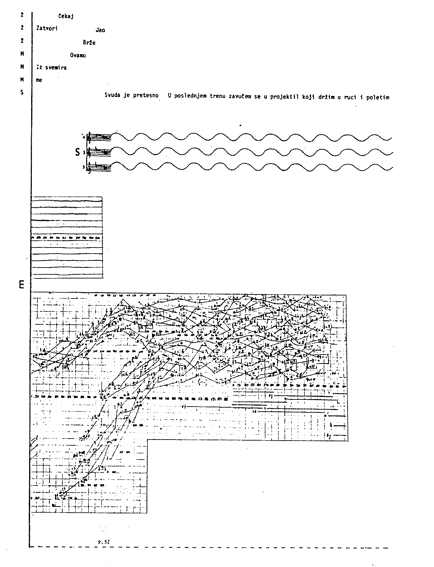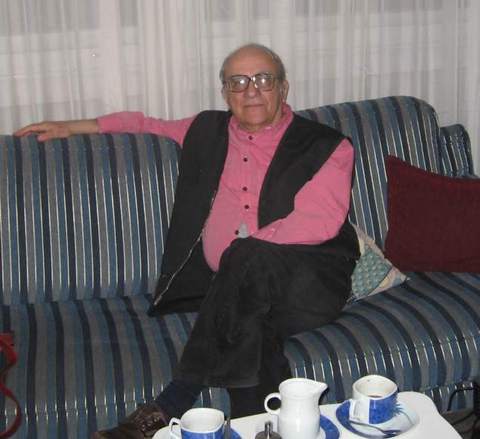Vladan Radovanovic: Arms (1992)
One of the coolest things that happened to me in Belgrade was that my musicologist friend Dragana Stojanovic-Novicic secured me an introduction to Vladan Radovanovic. Born in 1932, Radovanovic founded Yugoslavia’s first electronic music studio in Belgrade in 1972, and ran it until 1999. He first came to my attention as a supposed precursor of minimalism for some austere works he wrote in the ’50s, but that turns out to be the least of his achievements. He refers to his work as “Art Synthesis,” and besides being a composer he is an amazing painter, computer-graphics artist (see Arms, above), concrete poet, sculptor, and conceptualist. He makes images out of words, and writes texts of overlapping sentences that can be read in multiple directions – in Serbian, of course, so I couldn’t fully enjoy them, and they are untranslatable. One of his pieces is the Serbian word for mirror with eccentric capitalization – OGleDalo – bisected by a mirror, demonstrating that it can be written as a vertical panlindrome. He showed me a film called Variations (1985) in which the images of three musicians performing tunes he wrote use retrogrades, palindromes, canons, and such, correlating the visual processes with the musical devices. He’s made incredible artist’s books like Changes (1991-2), below, in which the images metamorphose continuously, encompassing the whole of human experience:
He’s got a text written on rings of paper inside a box that expand into a readable sphere when you open the box – I can’t describe it any better than that. He’s got a detailed portrait of Nicola Tesla made from a handwritten biography of the scientist done in different-colored inks. He played me a video of a piece called Constellations (1993-7) in which 12 singers carry lighted spheres while singing, and rearrange themselves in the form of various constellations in a darkened performance space. His music is often made from graphic scores, often employing spoken word and electronics, like this section from The Small Eternal Lake (1984):
He’s produced tons and tons of work, all seemingly thought-provoking, original, relentlessly crafted, and extremely clever. Belgrade gave him a major retrospective a few years ago, but he’s been out of touch with Western Europe because of Serbia’s political situation in the last couple of decades. And he and his wife Ljiljana treated me to an absolutely delicious dinner, surrounded on either side by fascinating conversation. I really felt that I had stumbled across an isolated genius – someone who, if he lived in Paris or Berlin or Warsaw, would be a household name.Â
Unlike his visual work, which seems to me completely sui generis, Radovanovic’s music roughly fits into a 1960s avant-garde East-European aesthetic, but it certainly has a distinct personality. I’m going to upload two longer works for you, because I think they’re worth the time. One is Vocalinstra (1972-76), a 21-minute work for voices and instruments that mimics electronic sounds without using electronics. The other is a more neoclassic Sinfonia Concertante from 1956, in which Radovanovic’s take on the style is idiosyncratically peculiar and kind of fascinating. I feel that this is far too little work to convey the Promethean impression he made on me, but it’s a start, and perhaps will inspire some research. As a composer alone, he would be a distinctive and prolific voice; as a visual artist, he’s an amazing innovator; as a poet I suspect he’s one-of-a-kind. As all three, and more besides, he makes the mind boggle at the unity-within-variety of his massive output.
Vladan Radovanovic at home, March 2010; and as a proto-performance artist in 1957:





